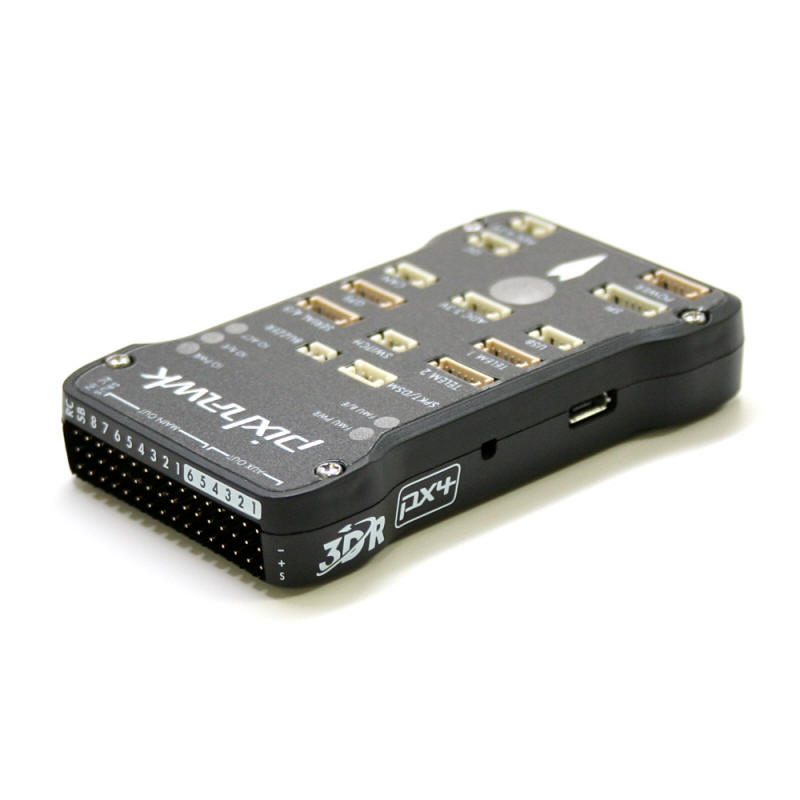
Pixhawk Details #1: Overview of the PX4 board series (old and new)
By PX4 [ http://diydrones.com/profile/PX4 ]
DIYDrones.com
September 1, 2013
The new PX4 Pixhawk module [ https://pixhawk.ethz.ch/px4/modules/pixhawk ] is an evolvement of the existing FMU [ https://pixhawk.ethz.ch/px4/modules/px4fmu ] and IO [ https://pixhawk.ethz.ch/px4/modules/px4io ] modules and completely compatible. The main difference is the target audience: While the FMU and IO stack is super small (the size of an average 8 ch RC receiver) but in some ways almost too densely packed, Pixhawk has more space, more serial ports and more PWM outputs.
As the above picture shows, there are two groups of servo connectors, one main group of 8 outputs which are wired through the backup processor, and an auxiliary group of 6 outputs directly wired to the main processor. The port labeled "RC" can take normal PPM sum or Futaba S.Bus inputs, the port labeled "SB" can read RSSI our output S.Bus to servos. A Spektrum satellite compatible port is on top (labeled SPKT/DSM).
The basic operation is the same, and the software is shared. Inside Pixhawk a FMUv2 and an IOv2 do their duties on a single board (and developers will find that the software will refer to FMUv2 and IOv2)
The main differences between old and new are:
Both generations offer the same backup / override processor that allows failover to manual if the autopilot fails in fixed wing setups. For software developers the differences are nicely abstracted in the PX4 middleware, and can be sensed / configured at runtime.
Pixhawk is available for pre-order here [ http://store.3drobotics.com/products/3dr-pixhawk ].
4:30am
by Crashpilot1000 [ http://diydrones.com/profile/Crashpilot1000 ]
September 1, 2013
What makes the ST sensorset superior to the Invense / Honeywell setup (like also used on Naza etc)?
7:40am
by Lorenz Meier [ http://diydrones.com/profile/LorenzMeier ]
September 1, 2013
7:46am
by Stefan Gofferje [ http://diydrones.com/profile/StefanGofferje ]
September 1, 2013
I wonder why the return to the integrated compass system. Wasn't there consent among the developers that the compass should be external and ideally far away from ESCs and motors? Or is this LM-model immune to EMI?
Is it possible to disable the integrated compass?
10:09am
by Chris Anderson [ http://diydrones.com/profile/zlitezlite ]
September 1, 2013
Stefan: It supports both external and internal mags (software switchable). Choice is up to user based on where the autopilot is placed.
10:15am
by Lorenz Meier
September 1, 2013
@Stefan: There is no return here. The internal compass is for free with this sensor setup, so no use not interfacing it. In contrast to APM 2.x hardware the external compass was always auto detected and the system startup will pick the external over the internal one.
If you connect a 3DR GPS with compass and orient the arrow front, you're immediately ready to go. You can also configure different orientations in the PX4 stack, and APM@PX4 has also the option to configure the compass orientation differently, if the arrow is not pointing front/up.
10:16am
by Stefan Gofferje
September 1, 2013
Chris, Lorenz:
Thanks for clearing that up! The automatic detection on startup is very cool! Is the Pixhawk as straightforward as the APM regarding config and firmware updates through mission planner? How about QGroundControl. I understand that QGC is supposed to be the primary GC for the PX4. Is that also valid for the Pixhawk? Is configuration/FW update possible through QGC? I would love that because then I could finally lose that Windows XP VM I am maintaining just for APM planner.
Pixhawk definitely looks like a very good option for my Y6 project.
12:30pm
by Chris Anderson
September 1, 2013
Stefan: we will be releasing new GCS software that works and looks like Mission Planner but is based on the cross-platform QGroundControl architecture.
12:33pm
Copyright 2013 http://diydrones.com/profiles/blogs/pixhawk-details-1-overview-of-the-px4-board-series-old-and-new